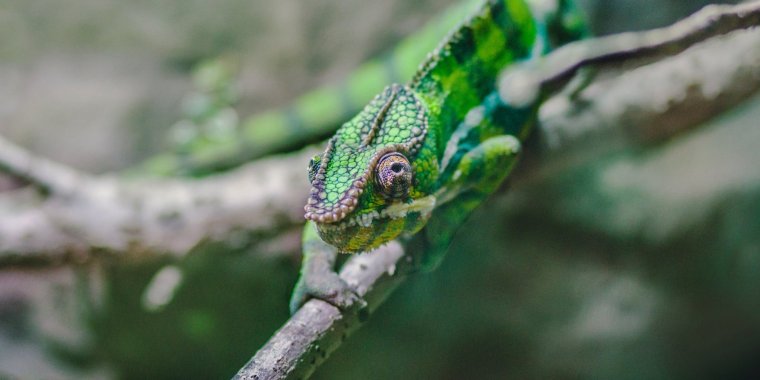| News / Science News |
Colour-changing artificial ‘chameleon skin’ powered by nanomachines
Researchers have developed artificial ‘chameleon skin’ that changes colour when exposed to light and could be used in applications such as active camouflage and large-scale dynamic displays.

In nature, animals such as chameleons are able to change colour. Photo: Viktor Kern/Unsplash
The material, developed by researchers from the University of Cambridge, is made of tiny particles of gold coated in a polymer shell, and then squeezed into microdroplets of water in oil. When exposed to heat or light, the particles stick together, changing the colour of the material.
In nature, animals such as chameleons and cuttlefish are able to change colour thanks to chromatophores: skin cells with contractile fibres that move pigments around. The pigments are spread out to show their colour, or squeezed together to make the cell clear.
The artificial chromatophores developed by the Cambridge researchers are built on the same principle, but instead of contractile fibres, their colour-changing abilities rely on light-powered nano-mechanisms, and the ‘cells’ are microscopic drops of water.
When the material is heated above 32C, the nanoparticles store large amounts of elastic energy in a fraction of a second, as the polymer coatings expel all the water and collapse. This has the effect of forcing the nanoparticles to bind together into tight clusters. When the material is cooled, the polymers take on water and expand, and the gold nanoparticles are strongly and quickly pushed apart, like a spring.
“Loading the nanoparticles into the microdroplets allows us to control the shape and size of the clusters, giving us dramatic colour changes,” said Dr Andrew Salmon from Cambridge’s Cavendish Laboratory, the study’s co-first author.
The geometry of the nanoparticles when they bind into clusters determines which colour they appear as: when the nanoparticles are spread apart they are red and when they cluster together they are dark blue. However, the droplets of water also compress the particle clusters, causing them to shadow each other and make the clustered state nearly transparent.
At the moment, the material developed by the Cambridge researchers is in a single layer, so is only able to change to a single colour. However, different nanoparticle materials and shapes could be used in extra layers to make a fully dynamic material, like real chameleon skin.
The researchers also observed that the artificial cells can ‘swim’ in simple ways, similar to the algae Volvox. Shining a light on one edge of the droplets causes the surface to peel towards the light, pushing it forward. Under stronger illumination, high pressure bubbles briefly form to push the droplets along a surface. (University of Cambridge)





